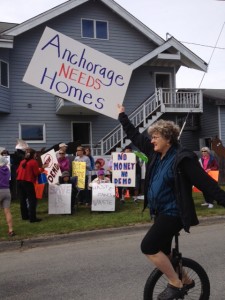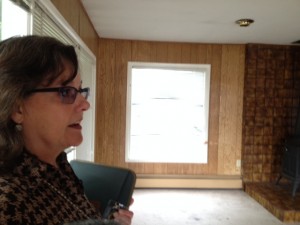
More than 50 people gathered in the Government Hill neighborhood this afternoon to protest the demolition of two homes. The state is clearing the land to make way for the proposed but not yet funded Knik Arm Bridge.
“Stop the demolition now! Stop the demolition now!” chanted a group of Anchorage residents from across the city standing in front of a blue house in Government Hill. They waved signs reading “Haste Makes Waste” and “Save our Homes.” Anne Reddig was with them.
“This is my neighborhood,” she said. “I live three houses this way. I don’t want a big gaping hole waiting for something that’s not funded. They’re taking away my neighborhood. They’re ruining where I live.”
Two houses and the old Sourdough Lodge are being demolished in preparation for the proposed $1.6 billion dollar Knik Arm Bridge. So far the state has only secured about $150 million for the project. The protesters say the state is moving too hastily — why should the state remove homes when it’s unclear if the project will actually happen? Most of the federal funding the state is trying to secure has historically gone toward projects in much larger, congested urban areas.
96-year-old Margery Ellis built her home in Government Hill in 1950. It’s set to be demolished during another phase of the project. “We don’t need terrorists when we have KABATA,” she said, referring to the project’s previous name. “Everything they’ve done is to destroy Government Hill, which is the oldest community in Anchorage.”
Before the protesters gathered, Department of Transportation spokeswoman Jill Reese and the property manager led a tour of the buildings.
“You probably just want to just wait,” the crowd of reporters at the bottom of the wooden stairs was told. “Have three people come up at a time. Because these are not very sturdy.”
The upstairs portion of the blue house was filled with sun from the skylights and soaring windows. But the musty ground floor had ripped up carpet and asbestos ceiling tiles. DOT’s Reese pointed out damage.
“Practically everything in the whole house would need to be redone. And as you’ll see there’s broken bathroom fixtures and those sorts of things.”
Reese said all three buildings are in the way of the bridge project. She explained the state moved quickly to purchase the buildings and relocate the tenants because that process can take a lot of time.
“You can’t wait until you’re ready with the financing to start building the bridge. You might be three or four years down the line just to get properties purchased. Also, especially in the Anchorage Bowl, prices aren’t going down.”
Reese said the state will pay for the removal of the buildings, which could cost between $500,000 to $1 million. Then they’ll be reimbursed if they get the federal grant. And the houses don’t have to be destroyed. Reese said they can also be moved to other parts of town. That’s what happened to some condos when Dowling Road was built.

“What we say is the market will speak. If there’s a dollar to be made on these properties in their whole form then I’m sure that is the route that will be taken. And if not then they will be demolished.”
All of the contractors who were walking through the properties during the protest declined to comment. They were examining the project before submitting bids by the 25th.
Some of the protesters said that it doesn’t matter if they tear down or relocate the buildings — it still leaves a hole in the neighborhood. And Lance Powell from Mid-Hillside said not only people in Government Hill should be concerned.
“Well if it can happen here, it can happen in any neighborhood in Anchorage.”
Powell says empty lots deter businesses and new residents from coming into the area. Others say large roads divide communities and cause deterioration, and that’s not what they want.
“What do we want?” cried a man over a bull horn.
“Homes!” responded the crowd.
“What do we need?” “Homes!” “What will we save?” “Homes!”
DOT has scheduled for the properties to be cleared by November and planted over with grass. They do not have a set schedule for when the bridge would be funded or built.
Anne Hillman is the healthy communities editor at Alaska Public Media and a host of Hometown, Alaska. Reach her at ahillman@alaskapublic.org. Read more about Anne here.





